A Better Future for the Planet Earth
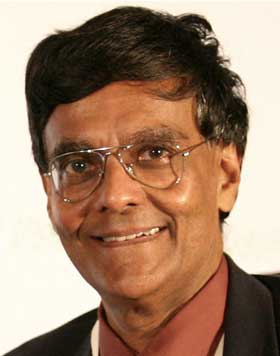
Prof. Mohan Munasinghe (Sri Lanka)
Born: 1945 / Sri Lanka
Founder Chairman, Munasinghe Institute for Development (MIND)
Early Childhood
In July 1945, Professor Munasinghe was born in Colombo, the capital of Sri Lanka. He spent most of his childhood in natural surroundings -- playing with his pet dog in the large garden at home, climbing trees, and catching fish in the stream behind his house. There were no TVs, mobile phones, or computer games. He loved to play outside, ride around on a bicycle with his friends, and listen to live cricket matches with them, with everyone’s ears glued to a transistor radio. He loved to read and was also interested in astronomy, having built his own reflector telescope to observe the stars.

1946, one year old

1953, age 8 – First Pet.
His earliest dream was to become a railway engine driver, but in high school he decided to study engineering, because his father was a top engineer and director of public works in Sri Lanka. His mother was a talented musician and writer who had won a state literary award. Altogether, young Mohan was an active, sociable child who was good at both studies and sports. He grew up happily in a family with his much admired and respected father, a loving, beautiful and intelligent mother, and three fond and caring older sisters who were six to eight years older.
Acquiring Multidisciplinary Skills

1961, Age 16. School years with elephant

1965, Age 20. Cambridge Years - Swiss ski trip
While Prof. Munasinghe was a good all-rounder in high school, he showed a special interest in English, mathematics and physics. His aptitude in English and mathematics developed because his mother taught him these subjects from an early age, while his interest in physics and mathematics was nurtured by two good teachers in high school.
After high school he studied engineering at Cambridge University, following his father. He went on to do an M.Sc. in electrical engineering at Massachusetts Institute of Technology and a Ph.D. in physics at McGill University (Canada) in 1973, to satisfy his early interest in those fields. Next, he obtained a Master's degree in Economics at Concordia University (Canada), as his interests shifted towards helping the poor in developing countries.

1967, Age 22. during MIT years
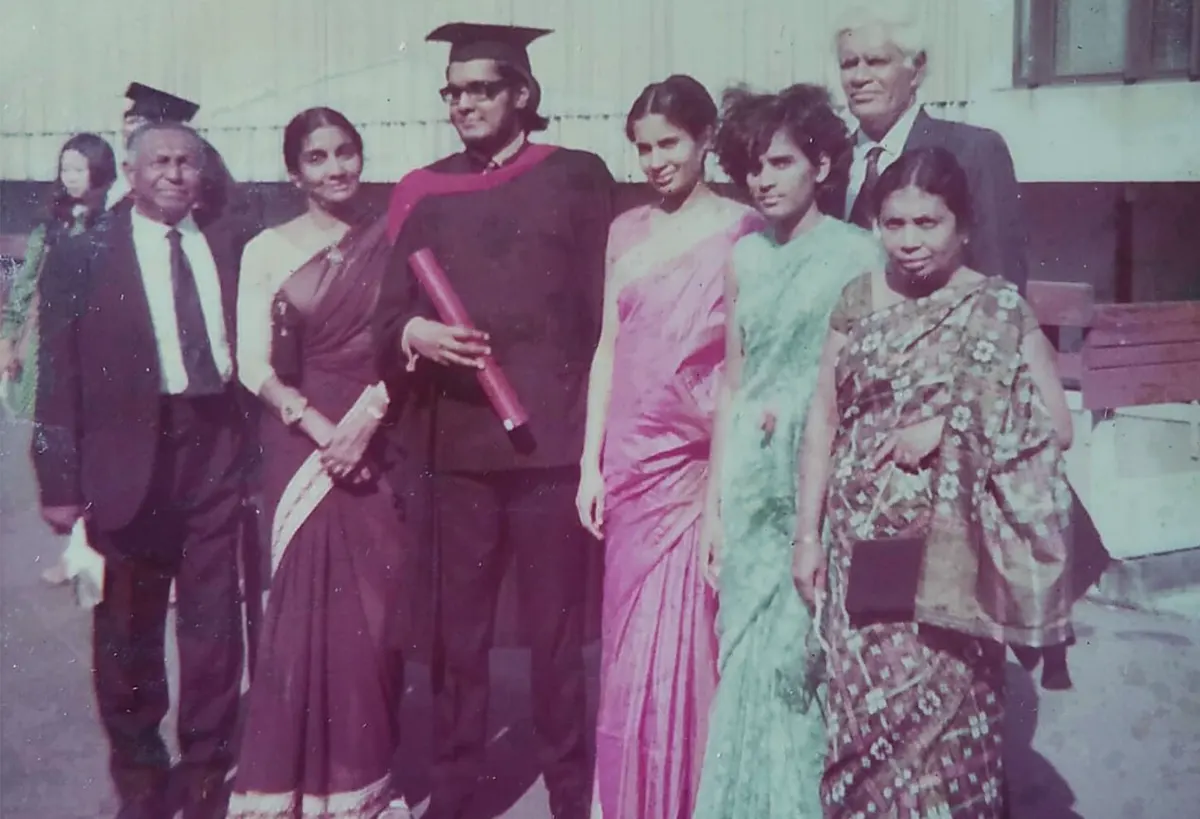
1973, Age 27. Graduation from McGill Univ.
The basic disciplines of engineering, physics and economics that he studied at university were helpful later when he applied this knowledge practically in sectors like energy, water, transport, digital technology, and environmental resources. His multi-disciplinary training was even more helpful when he began to work on complex topics like poverty, disasters, climate change and sustainable development. Meanwhile, his knowledge in mathematics and languages enhanced his analytical and communication skills. Studying engineering made him more aware of "how" things work and encouraged him to seek practical and win-win solutions in dealing with potentially conflicting goals. Physics made him think about "why" the universe is the way it is, while economics, functioned as a bridge to the social sciences. He believes that exposure to many fields during his academic journey was instrumental in developing a trans-disciplinary methodology for sustainable development that was later recognized globally as a key innovation.
Working at the World Bank and as Senior Advisor to the Sri Lankan President
In 1972, while completing his Physics PhD at McGill University, Prof. Munasinghe joined the International Institute of Quantitative Economics (IIQE), where Professor Inagaki, the Director encouraged him to study economics. The IIQE Director also passed him a recruitment advertisement for the Young Professionals Program at the World Bank. Prof. Munasinghe liked living in Montreal and was not very interested, but applied just to test the job market. After a rigorous selection process, he received an attractive offer from the World Bank. His first response was to request more time to consider the offer, which came as a surprise to the World Bank recruiter, because most candidates accepted such offers immediately. After consulting his wife and IIQE colleagues, he accepted the offer the next day. The couple left for Washington DC in 1975. This was a turning point in Prof. Munasinghe's life and opened up a career path to contribute to the developing world, instead of pursuing a career in engineering or physics.

1977, 31 years. with Parents & 3 sisters.
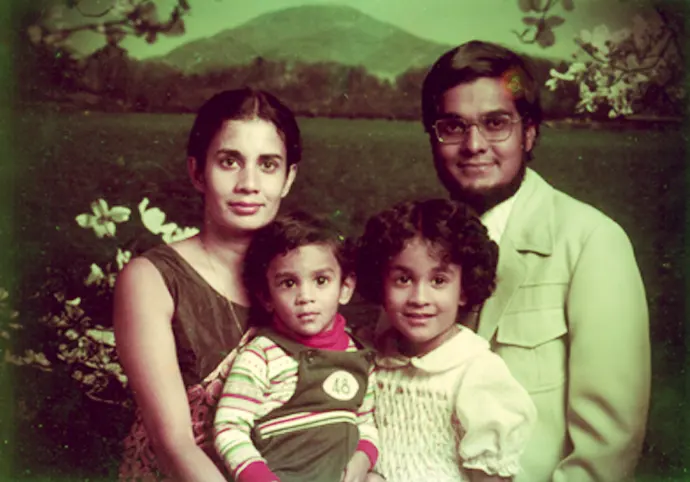
1979, age 34. Family portrait
As Prof. Munasinghe was making this transition from science to development economics, he consulted his great mentor whom he respected greatly -- Dr. Abdus Salam, a Nobel Physics Prize Laureate and also founder of the International Centre for Theoretical Physics (ICTP) in Trieste, Italy. He often invited Prof. Munasinghe to lecture to ICTP students and present conference papers. When Prof. Munasinghe told Dr. Salam that he would join the World Bank to work on poverty and development issues, Dr. Salam, sensed that he was torn between physics and economics. Nevertheless, he respected the young man’s decision and simply said, "What a loss to Physics!" It was one of the greatest intellectual compliments Prof. Munasinghe has ever received.
In 1980, five years after he joined the World Bank, Prof. Munasinghe got an unexpected offer. J.R. Jayewardene, President of Sri Lanka, requested him to become his senior energy advisor. It was a great honour for Prof. Munasinghe who was just about to turn 35 years old. So, for five years from 1982 to 1987, he took a leave of absence without pay from the World Bank and worked for President Jayewardene without remuneration. Working in a senior policy-making position in his home country provided invaluable practical experience, and also cemented his desire to pursue a career in energy, development and poverty alleviation.
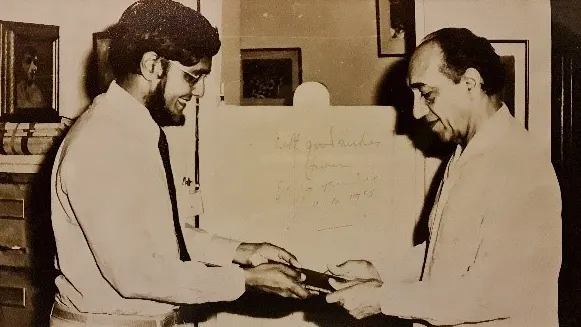
1983, Age 37. Autographed photo with Sri Lanka President Jayewardene
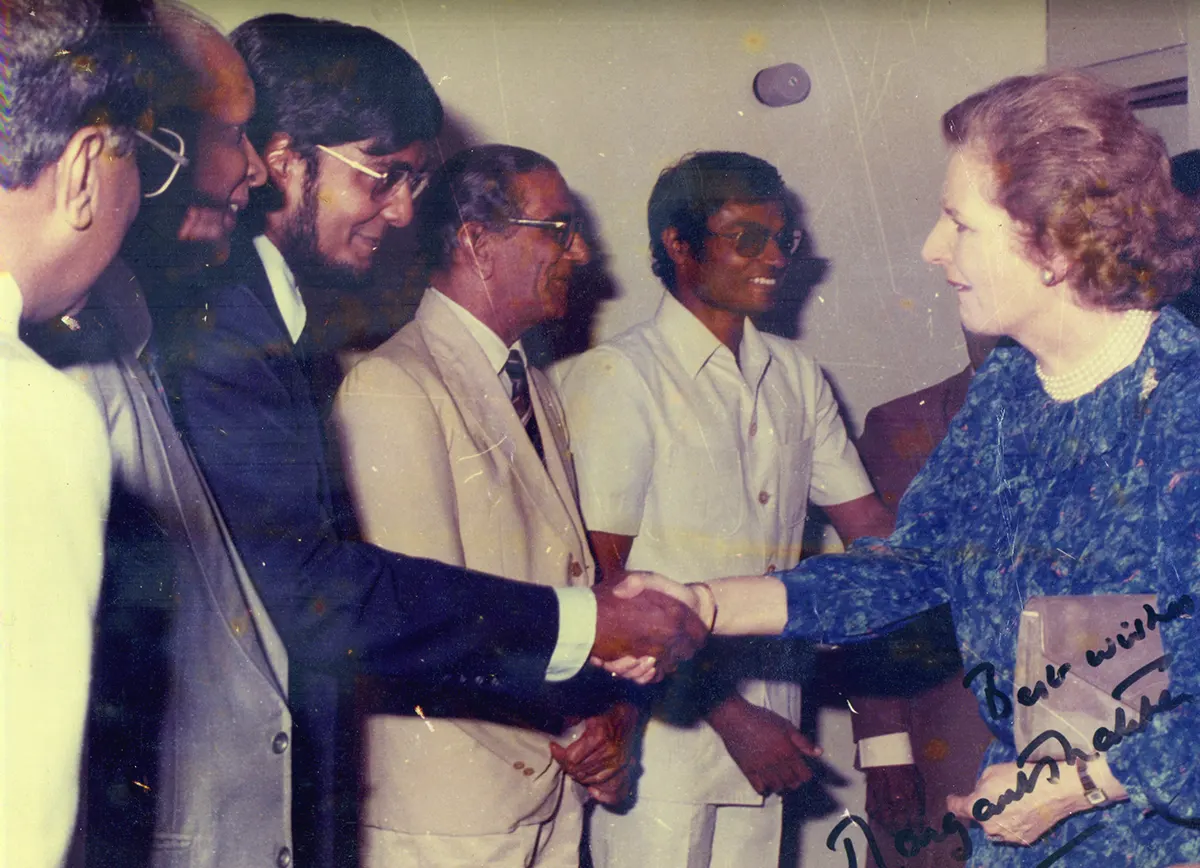
1984, age 37. Autographed photo with UK Prime Minister Margaret Thatcher
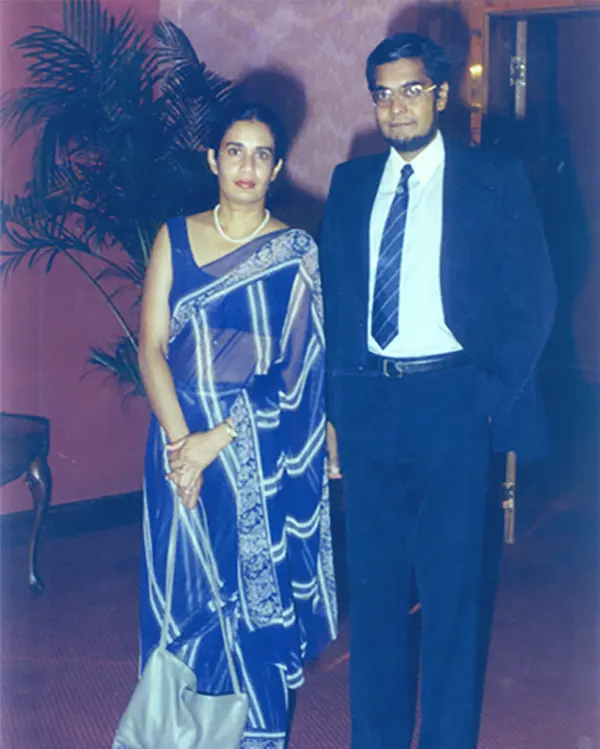
1986, age 41. with wife
Just before returning to the World Bank, he was asked by the President if he would be interested in a political career. Prof. Munasinghe replied that although he was honoured by the offer, he felt that he would be more effective in a behind-the-scenes policy advisory and implementation role. Nevertheless, the President’s suggestion indicated genuine appreciation of the work he had done for the government.
After returning to the World Bank in 1988, he became increasingly interested in the environment and climate change. In 1990, he was appointed Chief of Environmental Policy at the World Bank and began working with the Intergovernmental Panel on Climate Change (IPCC). Prof. Munasinghe's multidisciplinary background enabled him to make significant contributions to the IPCC, by integrating more economic and social insights into the analyses, and facilitating greater involvement of developing countries experts in IPCC work. From the early 1990s, he led the IPCC effort to integrate sustainable development and climate change. The success of this key initiative helped the IPCC win the 2007 Nobel Peace Prize, when Prof. Munasinghe was Vice Chair.
The Birth, Background and Many Disciplines of Sustainomics
In 1992, at the UN Rio Earth Summit, Professor Munasinghe made a globally significant announcement. He proposed his novel "Sustainomics" framework for making development more sustainable, which was designed to help world leaders overcome the challenges they faced. He was led to Sustainomics, by the contradictions in the global nexus of resource limits-inequality-poverty.
First, humanity’s ecological footprint is expanding. We are already overusing planetary ecological resources equivalent to 1.7 Earths, and by the year 2030, we will need the equivalent of two planets to sustain our current way of life. Secondly, it is the richest 20% of the world's population who consume more than 85% of planetary resources, which is 70 times more than the consumption of the poorest 20%. Third, we have not been able to eradicate poverty in the past, because when the rich over-consume, there are no resources left to help the poor. This is a major issue recognized by Sustainomics, because many promises have not been kept since the UN Universal Declaration of Human Rights (UNHDR) was endorsed by all countries in 1948. Today we have the Sustainable Development Goals (SDG), but all 17 of these goals were already contained in the original UNHDR -- highlighting that we have not been able to make any real progress for over 70 years! Professor Munasinghe saw the urgent need to overcome this impasse, and proposed Sustainomics as a potential solution.
So what is Sustainomics? There are four key principles. The first principle is to harmonize the sustainable development triangle, which includes three key dimensions: economic, environmental and social (Figure 1). Economic prosperity is necessary to help billions of poor people. However, it is equally important to protect nature (including the climate), because economic growth alone is unacceptable if it destroys the environment. We also need an inclusive social framework to reduce poverty and inequality. So the first principle involves balancing and integrating these three different goals.

Figure 1: Sustainable Development Triangle
The second principle is to make development more sustainable by empowering individuals to be proactive, without waiting for leaders to tell them what to do. We know what we have to do, like climbing a mountain, one step at a time. We can turn off unneeded lights, and water taps that are running. We can plant trees. We can do many things to improve sustainability -- in our schools, in our companies, in our towns, in our countries. This is the second principle.
The third principle is to break down and transcend the barriers in our own minds. The first barrier includes unsustainable values, like selfishness, corruption and violence which we all have within ourselves. It is important to overcome such obstacles and to adopt ethical values. The second barrier blocks stakeholder cooperation. In order to achieve a common goal, we need to work together, in particular, civil society and business must help government. The third barrier is spatial - we need to think of our city, country and whole world, not just our homes or neighbourhoods. The fourth mental barrier is time. We usually think about today, or maybe next month, but we need to consider the next year, next decade, and even 100 years ahead. Transcending barriers is the third principle.
The last principle is simple — implementing, by moving beyond debates, and taking action. There are many best practice examples and case studies, showing the application of Sustainomics tools, worldwide. So, implementing solutions is the fourth principle.
Balanced Inclusive Green Growth (BIGG) and Millennium Consumption Goals (MCGs)
When Sustainomics was presented at the 1992 Rio Earth Summit, there was considerable excitement, but in subsequent years, the euphoria ebbed. Prof. Munasinghe and his fellow scientists realized that harmonizing the sustainable development triangle was easier said than done. They needed to find practical solutions to convince powerful world leaders and policy-makers to apply the ideas of Sustainomics. This challenge led Prof. Munasinghe to propose the balanced inclusive green growth (BIGG) path. He started by reconciling two goals - economy and environment, instead of three. These two were chosen partly because of the common misconception that environmental protection required the sacrifice of economic growth. His "green economy" approach showed that the two goals were compatible, along a green growth path.
Figure 2: Economic development and environmental risk
Prof. Munasinghe started by examining the relationship between environmental harm (measured by GHG emissions per capita), and economic prosperity (measured by GNP per capita), shown in Figure 2. Poor nations are at point A — with low income and low emissions. Rich nations at point C are already unsustainable and exceeding safe ecological limits. He argued that wealthy countries can re-balance economy and environment and reach sustainable point E, by reducing environmental resource use while maintaining their good quality of life. They could use new resource efficient technologies, lifestyle changes, etc., that dematerialize modern economies. This is called green growth. Meanwhile, emerging nations at intermediate point B should learn from the past by innovating. They could go through the green growth (GG) tunnel to also reach point E, without exceeding safe limits by avoiding the unsustainable path of rich countries. This is how economy and environment are harmonized.
However, Prof. Munasinghe insisted on going beyond green growth, to also satisfy social goals. In the second step, green growth was further improved by adding pro-poor, inclusive and inequality-reducing policies, to create the balanced inclusive green growth (BIGG) path. This process fully harmonized the sustainable development triangle: economy, environment and society. Furthermore, the same BIGG path is generally available for other resources like energy, food and water, etc. This path increases resilience and helps us solve multiple sustainable development problems simultaneously, including poverty, hunger, energy, water, health, education, gender, etc., within the holistic framework of 17 SDG.
Meanwhile, in 2010 Prof. Munasinghe also proposed the concept of Millennium Consumption Goals (MCGs) based on Sustainomics. The MCG would require richer people in the world who consume most of global resources to adopt more sustainable consumption patterns, and thereby free up resources to help billions of poor. The MCG concept was later incorporated into the Sustainable Development Goals (SDG12 - Responsible Consumption and Production).
Creating His Own Non-profit Institute, MIND
Both the World Bank and IMF were controlled by rich countries who had consistently promoted economic growth, largely ignoring natural resource damage until clear evidence emerged in the 1980’s that some economic activities caused environmental harm. So when Prof. Munasinghe presented Sustainomics at the Rio Summit in 1992, he was asked by his World Bank colleagues, why as an economist, he was giving equal importance to the environment and society. He showed convincingly through his research that economics has its limitations, and that a cross-disciplinary approach was necessary.
As pressure from environmental, non-governmental organisations increased, in 1990 the World Bank appointed Prof. Munasinghe as Head of Environment Policy. He soon implemented many guidelines, including the environmental assessment manual which was applied to all Bank projects. In 1995, at the 50th anniversary of the IMF and World Bank, he was invited to give a keynote speech to the finance ministers of member countries. They were the Governors of the two institutions and had a very pro-economy mindset. He explained in economic terms, why the environment was important, and showed them how to change unsustainable practices and find new solutions. Thereby, Prof. Munasinghe spread the philosophy of environmental economics and sustainability at all levels of the World Bank (and IMF).
However, as he assumed higher and more responsible positions, he became increasingly involved in administration and had less time for research. He also became concerned, as political counter-pressures from powerful governments began to interfere with his science-based policy decisions. To the surprise of many colleagues, he decided to leave the World Bank ten years before his mandatory retirement age. He was determined to continue his work on sustainable development and tackle development issues by living in the developing world, rather than from a base in Washington. In 2000, he set up the Munasinghe Institute for Development (MIND) in Sri Lanka. It is now established as an UN-recognized centre of excellence for climate change and sustainable development, collaborating with international partners and engaging in public advocacy. MIND has given hundreds of scholarships to students and researchers, and conducted training courses for thousands of professionals.
Hobbies, Travel and Family
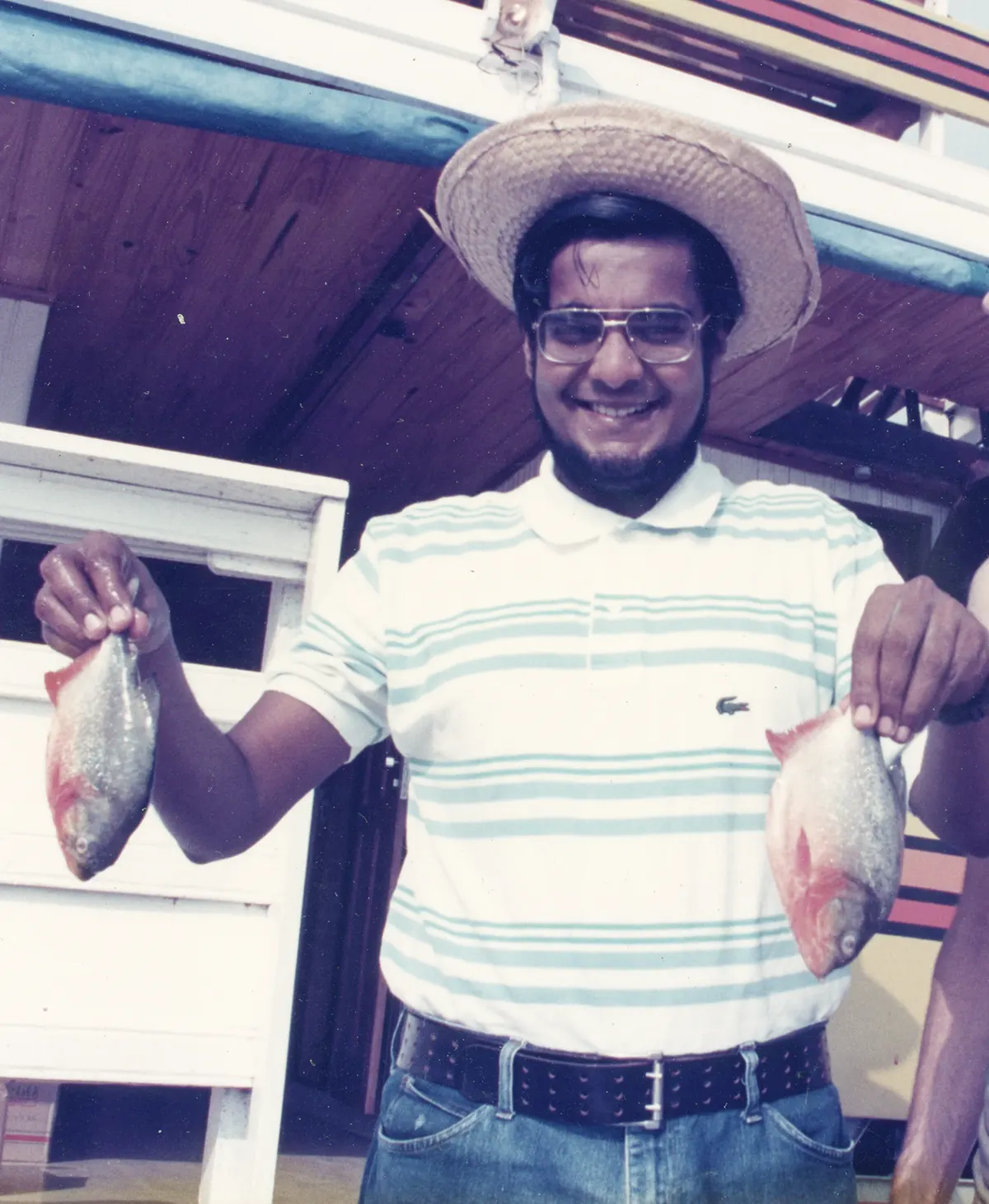
1989, Age 44. examining Piranha fish in Amazon

2001, Age 56. Egyptian pyramids
Prof. Munasinghe has wide interests, starting with various sports such as tennis, cricket, skiing, scuba diving, and judo. His pursuits include travelling the world (from student days), outdoor activities involving nature and animals, enjoying music, dancing, singing, practicing Tai-chi and meditation, etc., and he still continues to do many of these activities in his mid-70s. He also highly values living in a peaceful, harmonious and spiritual environment, so he and his wife designed their own "Japanese style" interior garden at home. It includes all those components that recreate his childhood roots when he enjoyed fresh air, sunshine, water, soil, flora and fauna. His workstation is surrounded by choice works of art from many countries, stimulating fresh ideas.

2003, Age 58. Mexican pyramid

2004, Age 59. in Sahara Desert

2005, Age 60. in Madagascar rainforest with snake.

2007, Age 62. Tibet Mt. Everest base camp. 5300 m.
He met his wife Sria when he was 14 years old, playing tennis at the same club. They eventually married in 1970 and recently celebrated their 51st wedding anniversary. His wife was the Sri Lankan National women's tennis champion, and they still play tennis together, three times a week. She also has a Master’s degree in Economics. Over all these years she has fully supported and shared his professional interests, as they followed a common path doing what they really wanted to do. She is prouder and happier of his success than anyone else. Their daughter Anusha has a Ph.D. in Molecular Biology from Harvard University, USA, and their son, Ranjiva, has his Ph.D. in Mathematics from Warwick University, UK. They also have two grandchildren — Linara and Ayaan.
What do his children think of their father? Anusha says that growing up with a dad who always did his best in everything, whether it was work, family or hobbies, had a lot of influence on her. His quiet support gave her the confidence that she could follow her dreams, and that gender was not a barrier to achievement. She says that her father's exposure to many cultures through his worldwide travels and adventures, made him a global citizen, and they had inherited these values.
Having a father who is a brilliant scientist has inspired Ranjiva in many ways - in particular to seek the truth through inquiry, logic and rational thinking. His love of mathematics and physics has definitely been influenced by his father. Other interests such as health, sports, languages, reading, and music grew from exposure to them at home. Watching the way his father leads his life, has taught Ranjiva to balance scientific analysis with culture, and develop good ethical values with emphasis on family.

2009, Age 64. with his wife, children & grandchildren
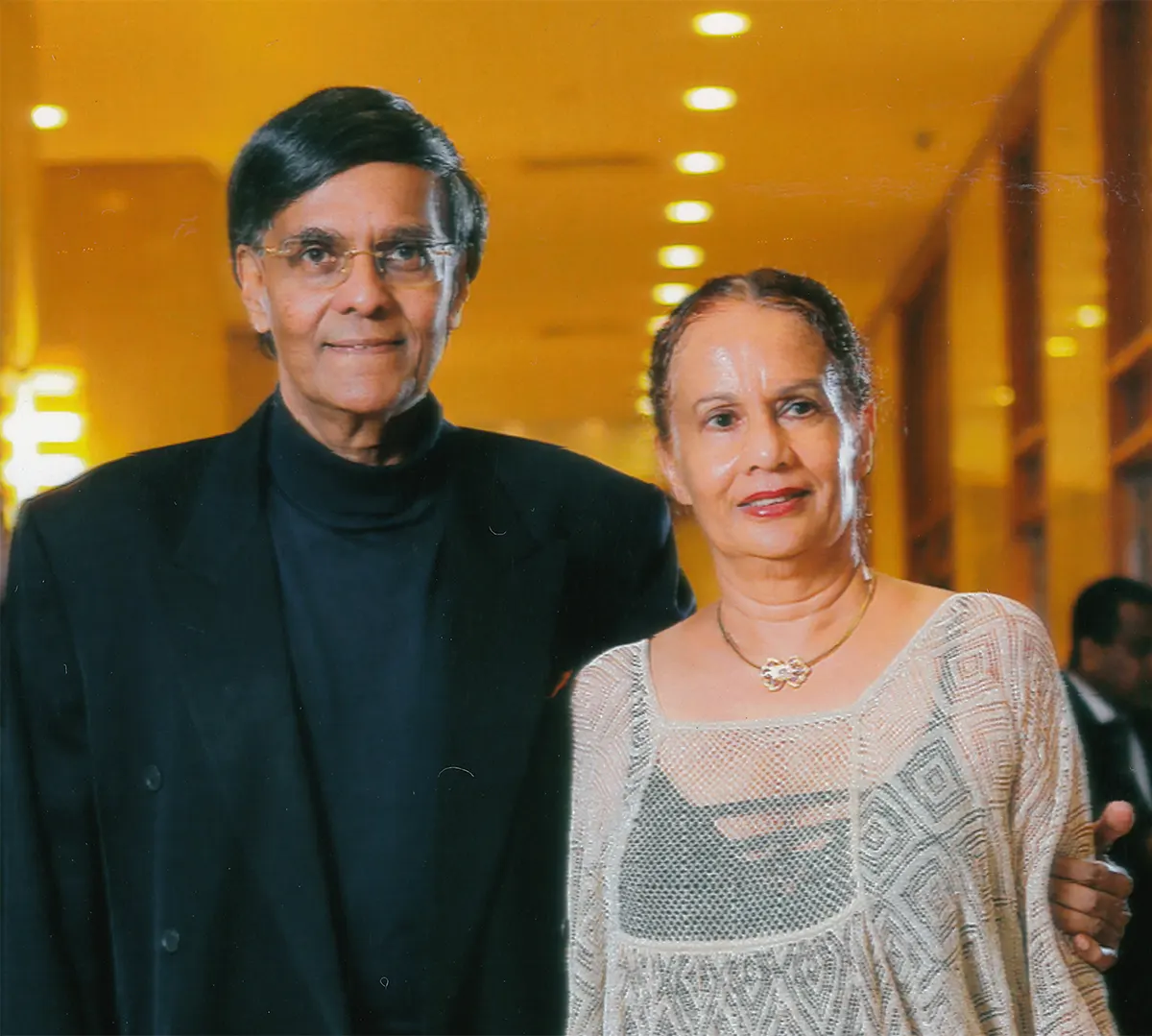
2012, Age 67. with wife Sria at dance
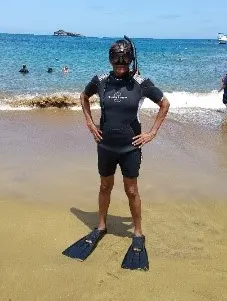
2015, Age 70. Diving in Galapagos
Message to the Young Generation
The problems we face today, such as sustainable development and climate change, are serious. However, we should never underestimate the power of the individual, starting with ourselves. We can address the many problems facing humanity, by harmonizing economic, environmental and social goals, and following Sustainomics principles, which include being self-motivated and acting decisively. Unsustainable behaviors are not difficult to identify, and we need not wait to be told what to do -- we can start with small steps like saving energy and water, or planting trees.
Global sustainable development is important, including economic prosperity, a green environment, and a peaceful, just and inclusive society. But before achieving this, we need to harmonize our own personal sustainability triangle — balancing first our work and career; second our health, fitness and environment; and finally our social interactions with family, friends and community. We have to harmonize ourselves from within to become well-balanced, ethical and compassionate human beings, before we can harmonize the planet outside us.
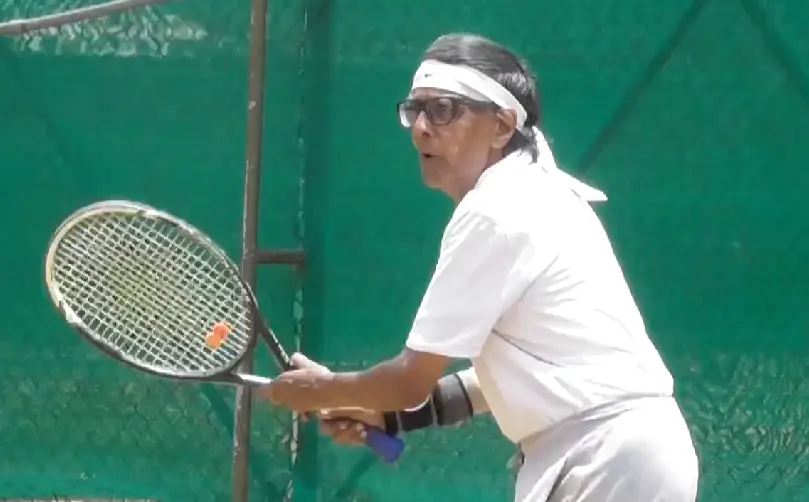
2021, Age 76. playing vigorous tennis
At age 76, I still work hard and stay fit, so that I can pass the torch to future generations all over the world, by teaching and giving them guidance. I still feel guilty that our generation has left them with so many problems! But I have great confidence that young people of the world with their new knowledge, innovative methods, and advanced technologies (like digital technology, biotechnology, social media, and so on), will find sustainable solutions to complex global problems.
Youngsters, you can solve the problems and make the world a better place! I wish you the very best in your future.